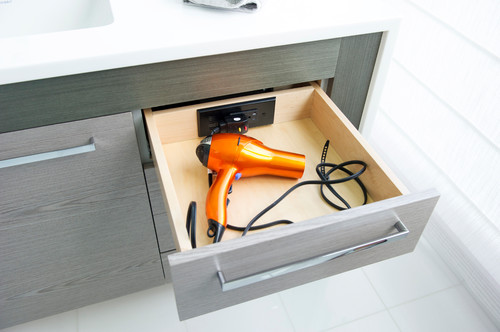
Did you see us featured on Houzz? If not, read the full article below or on Houzz's website here!
Chances are you're reading this article on your laptop, tablet or phone. When you're ready to charge that device, the cords will likely clutter up your desk, kitchen counter or nightstand — and your overall design. But that doesn't have to be the case. New York designers Gary Ciuffo of Ciuffo Cabinetry in Deer Park and Sarah Robertson of Studio Dearborn in Mamaroneck partnered with Docking Drawer, a pioneer of in-drawer electrical outlets, to share tips for safely installing a cutting-edge in-drawer charging or powering station and battling cord management.
Decide on Charging vs. Powering
According to Houzz's latest Kitchen Trends Study, 52 percent of homeowners are embracing docking stations. Before you join this growing trend, decide which kind of station you need: charging or powering. The in-drawer outlet seen in this kitchen is for charging devices such as wearable fitness trackers, phones and laptops. It has a built-in circuit breaker to prevent high-powered devices from being plugged in by mistake. (For those, you'd want a powering outlet.) Also remember to choose a charging outlet that has the right number of AC and USB outlets for your needs.
If you have devices that generate heat, such as hair dryers and curling irons, or are powered by a motor, such as mixers and laser printers, install an in-drawer powering outlet. Select one with a built-in thermostat that detects heat and automatically shuts off if you accidentally leave something on. "I get a huge sense of comfort knowing this is what these are designed to do," Robertson says.
Consider the Number of Devices
Think about how many devices your family uses. "I would say the average family member charges four devices at one time," Ciuffo says of phones, tablets, fitness trackers and laptops. "You plan what a customer says is average and shoot for growth." A 15-inch-wide charging drawer can usually accommodate as many as eight smaller devices at once. (An average cabinet drawer is 18 to 24 inches wide.)
Look for a slim in-drawer outlet such as the one seen here that doesn't require much space and comes fully assembled. Many pieced-together DIY solutions take up a lot of drawer space — and involve heavy modifications to the drawer box or cabinet — reducing the number of devices you can simultaneously charge or power.
Pick the Location
Decide on the right place for your in-drawer charging or powering station. Most homes have a landing zone, often in the kitchen, where family members set down their phones, keys, mail and more. A charging drawer can help keep this space organized. Think outside the kitchen too: Mudrooms, nightstands and home offices are other great places for in-drawer charging outlets. "If you're redoing an office and putting in cabinetry, adding this is a no-brainer," Robertson says.
In-drawer powering outlets such as the one seen here are commonly placed in bathrooms to help keep hair dryers, straighteners and curling irons in order. Select GFCI-protected outlets to keep you and your loved ones safe. These outlets are a must for kitchens, bathrooms and any other locations near a water source. Ciuffo strongly cautions against DIY retrofitting for any kind of in-drawer outlet. Electrical components available in hardware stores usually aren't designed for repeated movement such as opening and closing a drawer and can pose a safety risk. Most DIY outlets won't pass inspection or carry the ETL Listed Mark, a respected independent safety designation, he says.
Use drawer dividers to corral coiled cords, electronic accessories and gadgets in your charging drawers. Install canisters in various sizes to keep powering drawers organized. "The challenge is figuring out how that drawer can multitask to maximize the space," Robertson says. Adding labels and sticking to them helps keep things tidy, as does making a habit of using the charging or powering station.
"If I come across my son's iPad during the day, I put it in [the charging drawer]," Robertson says. "My family knows that if they've misplaced a phone or iPad, it's in there." Adjustable, removable dividers such as those seen here provide further flexibility to in-drawer charging stations. The black outlet used in this drawer blends into the dark wood for a streamlined look.
Organizing your devices — and conquering cord management — lets your home's design shine. Armed with these tips, you'll be able to create a reliable in-drawer charging or powering station that meets your needs and keeps clutter safely out of sight.
More: For more information on Docking Drawer, visit the company's website.




